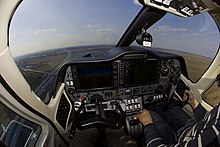Spherical compass

The spherical compass is the type of compass commonly used on ships and in small aircraft . The spherical compass consists of a liquid-filled glass sphere - hence the name - in which the compass rose with firmly integrated magnets is embedded freely rotating. The advantage of the spherical compass is that it can show the direction regardless of the position of the ship or aircraft and remains largely unaffected by the inclination , because the compass rose can move freely in any position.
construction
The distinguishing feature of a spherical compass is the surrounding glass sphere, typically 10-15 centimeters in diameter. The ball is permanently built into the bracket, either for bulkhead installation or for installation in the control column. In the first case the side is visible, in the second case the upper hemisphere (see pictures). The compass rose is firmly connected to the magnet below and rotates with it. The direction you are driving is read off by reading the value on the rose at the point marked with a line on the glass or on the housing. The sailing yacht in the picture above is traveling north-northeast at around 25 °. Auxiliary lines allow reading from the side. The compass rose, which can also be read from the side, is called the double rose .
The compass rose itself is either stored freely floating in the glass or suspended from a cardanic double joint . Weights under the rose keep it horizontally aligned, according to the principle of the standing man . There are small compensation magnets on the housing that can be used to correct gross deviation errors. However, a deviation table must be created for precise control . Significant display errors can occur, especially with ships made of steel. Not least because of this, large ships are increasingly using gyro compasses . But these are much more expensive, heavier and require energy.
The compass glass is filled with a special compass fluid. Depending on the manufacturer, different liquids are used, but they all have to meet the same criteria: They must not freeze in the cold and should have a very small expansion coefficient so that no bubbles form in the glass when the temperature fluctuates. Small pressure differences are compensated with a membrane. In addition, the liquid should of course be as transparent as possible. Various manufacturers use high-percentage alcohol as a compass liquid , which was sometimes tapped by thirsty sailors.
A small lamp is attached above or behind the compass which illuminates the digits at night so that the compass can also be used in the dark. The power supply wires must be twisted neatly so that the conductor does not build up an electromagnetic field that would deflect the compass.
use
Ball compasses are mainly used on smaller ships and aircraft. Large ships and commercial aircraft only use them as a fail-safe backup. Instead, gyro compasses or even inertial systems are used. Because the compass rose is freely positioned, spherical compasses work worldwide and even a significant inclination does not lead to a display error, but only to an inclination of the compass rose relative to the horizontal. Nevertheless, they are of course dependent on the earth's magnetic field and are influenced by magnetic declines . There are also small versions that are used as bearing compasses . Due to their large design and the not light weight due to the filling, they are still less suitable as a pocket compass for outdoor activities .
history
Up into the 19th century, shipping also used so-called dry compasses, in which the magnetic needle only rests on a thin pin but is otherwise undamped. However, this led to considerable reading problems on the violently moving ships, because the needle lurched so hard and also hit the housing or the base that reliable reading was not guaranteed. This can be significantly improved by filling the compass housing with a dampening liquid (which is why most pocket compasses today are no longer dry compasses despite their flat design).
Individual evidence
- ↑ a b c d Bobby Schenk: Yacht navigation . 9th edition. Delius Klasing Verlag, Bielefeld 2006, ISBN 978-3-7688-1818-6 , p. 67, 68 .
- ^ Joachim Schult: Segler-Lexikon ; Delius-Klasing-Verlag; Bielefeld 2008; ISBN 978-3-7688-1041-8 ; Keyword double rose
- ↑ a b seamanship ; Delius-Klasing-Verlag; Bielefeld 2008; ISBN 978-3-7688-0523-0 ; 28th edition, p. 451
- ↑ Compass fluid . Optics lexicon. Retrieved March 11, 2018.
literature
- Seamanship ; Delius-Klasing-Verlag; Bielefeld 2008; ISBN 978-3-7688-0523-0 ; 28th edition, pp. 450f
- Joachim Schult: Segler-Lexikon ; Delius-Klasing-Verlag; Bielefeld 2008; ISBN 978-3-7688-1041-8 ; Keywords ball compass , compass , double Rose


